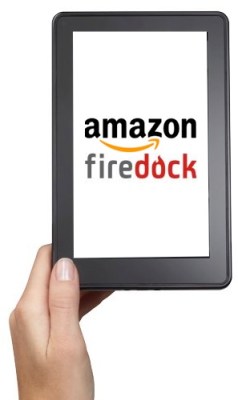For most geeks, uttering the word “Firedock” conjures up images of this Kindle Fire-friendly speaker dock that was announced back in March.
But something interesting happened last month — Grace Digital released that very same Kindle Fire speaker dock under a different name on July 17. That by itself isn’t much to write home about, but The Digital Reader points out that Amazon now owns the FireDock trademark. A little digging reveals that Grace Digital transferred the trademark to Amazon Technologies (an Amazon.com subsidiary based in Nevada) just a few days earlier, on July 11.
So what gives? What is the Firedock? Looking at the goods and services that the trademark encompasses doesn’t provide too many concrete hints just because there are so damned many of them, but they do seem to point to an actual, physical product rather than a service. Still, it seems unlikely that Amazon would take control of the Firedock trademark just to push out something like a run-of-the-mill speaker dock (sorry Grace Digital, I’m sure your Matchstick is a real sweetheart).
Given some of the rumors about swirling around the new Kindle Fire (which may or may not have just passed through the FCC) and the stiff competition in the low-end tablet space, I wouldn’t be at all surprised if the Firedock turned out to be an accessory to bolster Amazon’s play for the living room. You pop the new Kindle Fire into a Firedock (naturally), run it into a television and maybe a sound system, and voila — you’ve got a tablet that doubles as a video and music hub.
Hear me out on this one. It’s no secret that the low-cost Kindle Fire is something of a Trojan horse for all of Amazon’s media services — that’s music, television shows, and movies in addition to just books. Users get a free month of Amazon Prime and its related video service when you buy a Kindle Fire (a promotion that I doubt is going anywhere), and Amazon still hopes that the trial is enough to entice people into ponying up the annual fee. What’s more, recent rumors have pegged the forthcoming Kindle Fire 2 with an HDMI-out port, which would finally allow Kindle users to display all that content on a bigger screen.
Sure, there’s no shortage of televisions and discrete video boxes that could deliver Amazon’s Prime content to a television — there’s the Boxee, Roku’s line of cute black boxes, etc. — but that requires a commitment to the concept of streaming video. Not everyone is going to have that particular impulse, but for new Kindle Fire owners (who, don’t forget, have access to plenty of free premium content for a while), the ability to pick up an accessory that extends the use of a gadget they already want doesn’t seem like much of a leap. Once those components are in place and the setup’s value is seen, it may become even more difficult not to pay the $79 for continued Prime service. That’s what Amazon is really after.
Beyond the revenues generated from new Prime subscriptions, a move like that could help poke at Amazon’s search-focused rival. Google’s own low-cost tablet may well exceed the company’s sales expectations, but their living room-oriented media streamer wasn’t quite ready for prime time. Still, the company is clearly making what plays it can, and Amazon may be able to throw a wrench into things. If we take the new Kindle Fire to be Amazon’s Trojan horse, and the living room to be Troy, then the Firedock may well be the guy who knocked on the gates.
